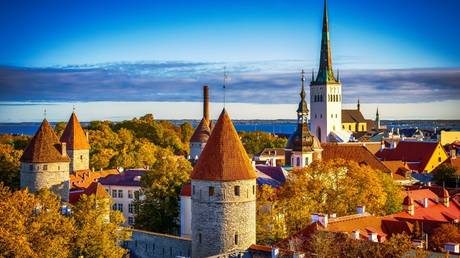
A “highly transmissible” and “virulent respiratory illness” for which there is no cure may incite a global pandemic. That was the assessment of a 2008 US intelligence report. The prediction was accurate — but no one was prepared.
That forecast flew mostly under the radar, but quotes from the prescient National Intelligence Council (NIC) report were published in a 2009 book by French historian and philosopher Alexandre Adler.
In a recent interview, Adler rejected the “prophet status” he has been granted for highlighting the warning and expanding on the potential implications, saying that it was just “one of many” US intelligence reports that had pointed to a pandemic as a potential source of new global destabilization. The problem was, he said, most people weren’t listening. The feeling was that these things “only happen to others.”
Indeed, even when the novel coronavirus was ripping through China and claiming hundreds of lives daily, the West failed to mobilize a response to the crisis charging down the tracks. It took Italy becoming the European Union’s patient zero and heading into dire straits for Brussels to jolt itself into action and agree on a coordinated response to the problem — after thousands had lost their lives.
US President Donald Trump (not to mention plenty of other officials around the world) have insisted that no one could have foreseen an outbreak similar to the one the world is witnessing — but it seems that plenty of experts did foresee, in eerily accurate details, something exactly like this pandemic unfolding.
Warning after warning
Let’s look at the details of that 2008 NIC report.
It warned that this new disease could be “extremely contagious” and that there would be “no adequate treatment” available at the time of its spread, leading to worldwide pandemic. It suggested that highly pathogenic strains of bird flu like H5NI were “likely candidates,” but a “coronavirus or other influenza strains” could have the same potential.
It said this outbreak would begin in an area of high population density and where humans and animals often live in close quarters, giving China as a specific example. The Covid-19 virus is said to have originated at a wet market in Wuhan, where live and dead animals are sold and where hygiene standards are poor.
When the virus began to spread, a “slow public health response” would hinder the realization that a highly dangerous pathogen was spreading. “Weeks might pass” before laboratory results could confirm its existence, and by then clusters would be appearing in the population. Asymptomatic travelers could then carry the disease to other continents resulting in “waves” of new cases internationally. In the most extreme scenario “tens to hundreds of millions” of Americans could become ill.
A pandemic was also cited in a 2004 NIC report as something that could “derail globalization,” noting that experts believe such an event is “only a matter of time.”
While these predictions might sound spookily psychic to the layperson, they were merely common sense to virologists and other experts who have been warning about the inevitability of a new pandemic (and the world’s lack of preparedness) for years.
In 2005, infectious disease expert Michael Osterholm wrote that “time is running out” to prepare for the next pandemic and that it was time to act. In his 2017 book ‘Deadliest Enemy: Our War Against Killer Germs,’ he attempted to sound the alarm on emerging threats and he laid out a nine-point strategy to protect populations.
Similarly, influenza expert Robert Webster warned in his 2018 book Flu Hunter of the “enormous social disruption and substantial economic cost” that could result from another worldwide pandemic.
Experts closer to the halls of power have been raising the alarm, too.
Dennis Carroll headed a USAID program called PREDICT, which led research into viruses in animals that could be transmitted to people. He championed the cause of investing in research into wildlife, not just livestock — and as we know now, the novel coronavirus is believed to have passed from bats to humans. PREDICT lost its funding in 2019. Now, the Trump administration is trying to revive the program.
It’s not only US government agencies that have been forewarning about a new viral outbreak, either.
German predictions
A 2012 German government risk analysis also highlighted the threat. In its pandemic simulation, the new virus would spread rapidly to overwhelm health systems and intensive care units. As a result, it said many patients would be cared for in emergency hospitals — exactly the scenario we are seeing play out today. Like the US report, it too predicted the virus would begin in Asia — and even that it would be transmitted from wild animals to humans.
The report predicted that the spread of the virus would be slowed by “anti-epidemic measures” including quarantining, contact-tracing and self-isolation — in addition to school closures and bans on large gatherings. Most of the population, it said, would behave “largely in solidarity” but anti-social behavior could not be “ruled out.” It did not give concrete estimates on economic impact, but said it would be “immense.”
The German government report also suggested the virus would spread through the country over a three-year period before a vaccine became available. It assumed 7.5 million deaths based on an extremely high mortality rate of 10 percent. As of now, we don’t yet know the overall mortality rate for Covid-19. For a variety of reasons, it has ranged from over 7 percent in Italy to a very low 1.6 percent in Germany. The World Health Organization predicted a global average death rate of 3.4 percent.
With all of these prescient and uncannily precise warnings, why then, was the world so unprepared? The Covid-19 crisis has unsurprisingly stirred many new conspiracy theories; from the suggestion that the virus is a bioweapon created in a Chinese lab, to the theory that there is a link between the illness and 5G technology, or that the US army unleashed it in Wuhan at the 2019 Military World Games — there have been no shortage of wild theories as to where it came from and how it was born.
But none of those theories can explain why the entire world was unprepared to confront a scenario experts have been consistently warning about for years.
‘It won’t happen to us’
Perhaps the explanation is less conspiratorial and more…human. Perhaps it is as simple as the fact that humans are reluctant to prepare for “maybes” and nebulous future crises, preferring instead to deal with problems only as they arrive at the front step and begin breaking down the door.
One of the only exceptions to this rule seems to be military preparedness: There may be no money to prepare for a pandemic, but there’s always plenty of money to prepare for war — even during a pandemic. A Declassified UK analysis published last month found that the UK had done no planning for a pandemic, despite repeated warnings by policy-making officials over 15 years that an influenza outbreak was the “gravest threat” to UK security.
Despite ample warning, the response to the spread of the virus was painfully slow in the West. While Trump and British PM Boris Johnson have been rightly panned by experts for not taking the outbreak seriously enough in its early stages, Brussels too slept-walked into the crisis. There may be a kind of hubris attached to that sluggish Western response. As Adler commented, it’s easier to assume that these things will “happen to others” but never us — and only when people realize that they are all in the same sinking boat can progress begin.
Think your friends would be interested? Share this story!




